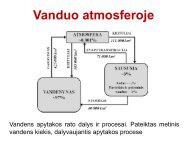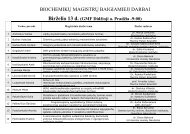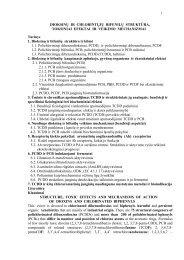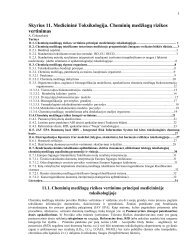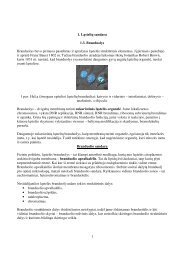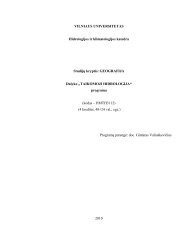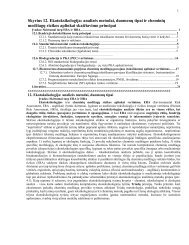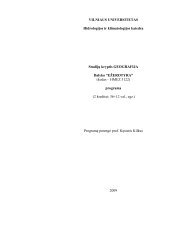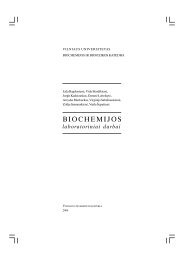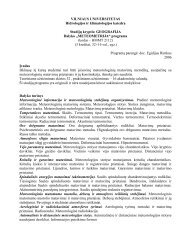494 CHAPTER TWENTY-FOURswords have differentiated very little in their chloroplastgenes.The isl<strong>and</strong> silverswords are more diverse in size <strong>and</strong>shape than the mainl<strong>and</strong> tarweeds because the original colonizersarrived on isl<strong>and</strong>s that had very few plant species. Inparticular, there were few trees <strong>and</strong> shrubs, because suchlarge-seeded plants rarely disperse to oceanic isl<strong>and</strong>s. In fact,many isl<strong>and</strong> trees <strong>and</strong> shrubs have evolved from nonwoodyancestors. On the mainl<strong>and</strong>, however, tarweeds live in ecologicalcommunities that contain tree <strong>and</strong> shrub lineagesolder than their own—that is, where opportunities to exploitthe “tree” way <strong>of</strong> life have already been preempted.The processes we have discussed in this chapter, operatingover billions <strong>of</strong> years, have produced a world in which life isorganized into millions <strong>of</strong> species, each adapted to live in aparticular environment <strong>and</strong> to use environmental resourcesin a particular way. How these millions <strong>of</strong> species are distributedover the surface <strong>of</strong> Earth <strong>and</strong> organized into ecologicalcommunities will be a major focus <strong>of</strong> Part Eight <strong>of</strong> this book.Chapter SummaryWhat Are <strong>Species</strong>? <strong>Species</strong> are independent evolutionary units. A commonlyaccepted definition <strong>of</strong> species is “groups <strong>of</strong> actually or potentiallyinterbreeding natural populations which are reproductivelyisolated from other such groups.” Because speciation is <strong>of</strong>ten a gradual process, it may be difficultto recognize boundaries between species. Review Figure 24.3How Do New <strong>Species</strong> Arise? Not all evolutionary changes result in new species. Allopatric (geographic) speciation is the most importantmode <strong>of</strong> speciation among animals <strong>and</strong> is common in othergroups <strong>of</strong> organisms. Review Figures 24.4, 24.5, 24.6.See Web/CD Tutorial 24.2 Sympatric speciation may occur rapidly by polyploidybecause polyploid <strong>of</strong>fspring are sterile in crosses with members<strong>of</strong> the parent species. Polyploidy is a major factor in plant speciationbut is rare among animals. Review Figures 24.7, 24.8See Web/CD Tutorial 24.1Completing Speciation: Reproductive IsolatingMechanisms Once two populations have been separated, reproductive isolatingmechanisms may prevent the exchange <strong>of</strong> genes betweenthem. Prezygotic reproductive barriers operate before fertilization.Some prezygotic barriers affect mate choice; others work byinfluencing pollinator behavior. Review Figure 24.10, 24.11 Postzygotic reproductive barriers operate after fertilization byreducing the survival or fertility <strong>of</strong> hybrid <strong>of</strong>fspring. If hybrid <strong>of</strong>fspring survive poorly, more effective prezygoticreproductive barriers may evolve. This process is known asreinforcement. Review Figure 24.12Hybrid Zones: Incomplete Reproductive Isolation Hybrid zones may develop if barriers to gene exchange fail todevelop while diverging species are isolated from each other.Review Figure 24.13 <strong>Species</strong> may differ from one another in very few genes.Variation in Speciation Rates Rates <strong>of</strong> speciation differ greatly among lineages. Speciationrates are influenced by the number <strong>of</strong> species in a lineage, theirdispersal rates, ecological specialization, experience <strong>of</strong> populationbottlenecks, pollinators, <strong>and</strong> behavior, as well as by climaticchanges.Evolutionary Radiations Evolutionary radiations occur when speciation rates exceedextinction rates. High speciation rates <strong>of</strong>ten coincide with low extinction rateswhen species invade isl<strong>and</strong>s or other environments that containfew other species. As a result <strong>of</strong> speciation, Earth is populated with millions <strong>of</strong>species, each adapted to live in a particular environment <strong>and</strong> touse resources in a particular way.See Web/CD Activity 24.1 for a concept review <strong>of</strong> this chapter.Self-Quiz1. A species is a group <strong>of</strong>a. actually interbreeding natural populations that arereproductively isolated from other such groups.b. potentially interbreeding natural populations that arereproductively isolated from other such groups.c. actually or potentially interbreeding natural populationsthat are reproductively isolated from other such groups.d. actually or potentially interbreeding natural populationsthat are reproductively connected to other such groups.e. actually interbreeding natural populations that arereproductively connected to other such groups.2. Allopatric speciation may happen whena. continents drift apart <strong>and</strong> separate previously connectedlineages.b. a mountain range separates formerly connected populations.c. different environments on two sides <strong>of</strong> a barrier causepopulations to diverge.d. the range <strong>of</strong> a species is separated by loss <strong>of</strong> intermediatehabitat.e. all <strong>of</strong> the above3. Finches speciated in the Galápagos Isl<strong>and</strong>s becausea. the Galápagos Isl<strong>and</strong>s are not far from the mainl<strong>and</strong>.b. the Galápagos Isl<strong>and</strong>s are arid.c. the Galápagos Isl<strong>and</strong>s are small.d. the isl<strong>and</strong>s <strong>of</strong> the Galápagos Archipelago are sufficientlyisolated from one another that there is little migrationamong them.e. the isl<strong>and</strong>s <strong>of</strong> the Galápagos Archipelago are closeenough to one another that there is considerablemigration among them.4. Which <strong>of</strong> the following is not a potential prezygoticreproductive barrier?a. Temporal segregation <strong>of</strong> breeding seasonsb. Differences in chemicals that attract matesc. Hybrid infertilityd. Spatial segregation <strong>of</strong> mating sitese. Sperm cannot survive in female reproductive tracts
SPECIES AND THEIR FORMATION 4955. A common means <strong>of</strong> sympatric speciation isa. polyploidy.b. hybrid infertility.c. temporal segregation <strong>of</strong> breeding seasons.d. spatial segregation <strong>of</strong> mating sites.e. imposition <strong>of</strong> a geographic barrier.6. Sympatric species are <strong>of</strong>ten similar in appearance becausea. appearances are <strong>of</strong>ten <strong>of</strong> little evolutionary significance.b. the genetic changes accompanying speciation are <strong>of</strong>tensmall.c. the genetic changes accompanying speciation are usuallylarge.d. speciation usually requires major reorganization <strong>of</strong> thegenome.e. the traits that differ among species are not the same as thetraits that differ among individuals within species.7. Narrow hybrid zones may persist for long times becausea. hybrids are always at a disadvantage.b. hybrids have an advantage only in narrow zones.c. hybrid individuals never move far from their birthplaces.d. individuals that move into the zone have not previouslyencountered individuals <strong>of</strong> the other species, so reinforcement<strong>of</strong> isolating mechanisms has not occurred.e. Narrow hybrid zones are artifacts because biologistsgenerally restrict their studies to contact zones betweenspecies.8. Which statement about speciation is not true?a. It always takes thous<strong>and</strong>s <strong>of</strong> years.b. It <strong>of</strong>ten takes thous<strong>and</strong>s <strong>of</strong> years, but may happen withina single generation.c. Among animals, it usually requires a physical barrier.d. Among plants, it <strong>of</strong>ten happens as a result <strong>of</strong> polyploidy.e. It has produced the millions <strong>of</strong> species living today.9. Speciation is <strong>of</strong>ten rapid within lineages in which specieshave complex behavior becausea. individuals <strong>of</strong> such species make fine discriminationsamong potential mating partners.b. such species have short generation times.c. such species have high reproductive rates.d. such species have complex relationships with theirenvironments.e. none <strong>of</strong> the above10. Evolutionary radiationsa. <strong>of</strong>ten happen on continents, but rarely on isl<strong>and</strong>archipelagos.b. characterize birds <strong>and</strong> plants, but not other taxonomicgroups.c. have happened on continents as well as on isl<strong>and</strong>s.d. require major reorganizations <strong>of</strong> the genome.e. never happen in species-poor environments.11. Speciation is an important component <strong>of</strong> evolution becauseita. generates the variation upon which natural selection acts.b. generates the variation upon which genetic drift <strong>and</strong>mutations act.c. enabled Charles Darwin to perceive the mechanisms <strong>of</strong>evolution.d. generates the high extinction rates that drive evolutionarychange.e. has resulted in a world with millions <strong>of</strong> species, eachadapted for a particular way <strong>of</strong> life.For Discussion1. The snow goose <strong>of</strong> North America has two distinct colorforms: blue <strong>and</strong> white. Matings between the two color formsare common. However, blue individuals pair with blue individuals<strong>and</strong> white individuals pair with white individualsmuch more frequently than would be expected by chance.Suppose that 75 percent <strong>of</strong> all mated pairs consisted <strong>of</strong> twoindividuals <strong>of</strong> the same color. What would you concludeabout speciation processes in these geese? If 95 percent <strong>of</strong>pairs were the same color? If 100 percent <strong>of</strong> pairs were thesame color?2. Suppose pairs <strong>of</strong> snow geese <strong>of</strong> mixed colors were found onlyin a narrow zone within the broad Arctic breeding range <strong>of</strong>the geese. Would your answer to Question 1 remain thesame? Would your answer change if mixed-color pairs werewidely distributed across the breeding range <strong>of</strong> the geese?3. Although many butterfly species are divided into local populationsamong which there is little gene flow, these species<strong>of</strong>ten show relatively little morphological variation amongpopulations. Describe the studies you would conduct todetermine what maintains this morphological similarity.4. Evolutionary radiations are common <strong>and</strong> easily studied onoceanic isl<strong>and</strong>s, but in what types <strong>of</strong> mainl<strong>and</strong> situationswould you expect to find major evolutionary radiations?Why?5. Fruit flies <strong>of</strong> the genus Drosophila are distributed worldwide,but most <strong>of</strong> the species in the genus are found on theHawaiian Isl<strong>and</strong>s. What might account for this distributionpattern?6. Evolutionary radiations take place when speciation ratesexceed extinction rates. What factors can cause extinctionrates to exceed speciation rates in a lineage? Name some lineagesin which human activities are increasing extinction rateswithout increasing speciation rates.



